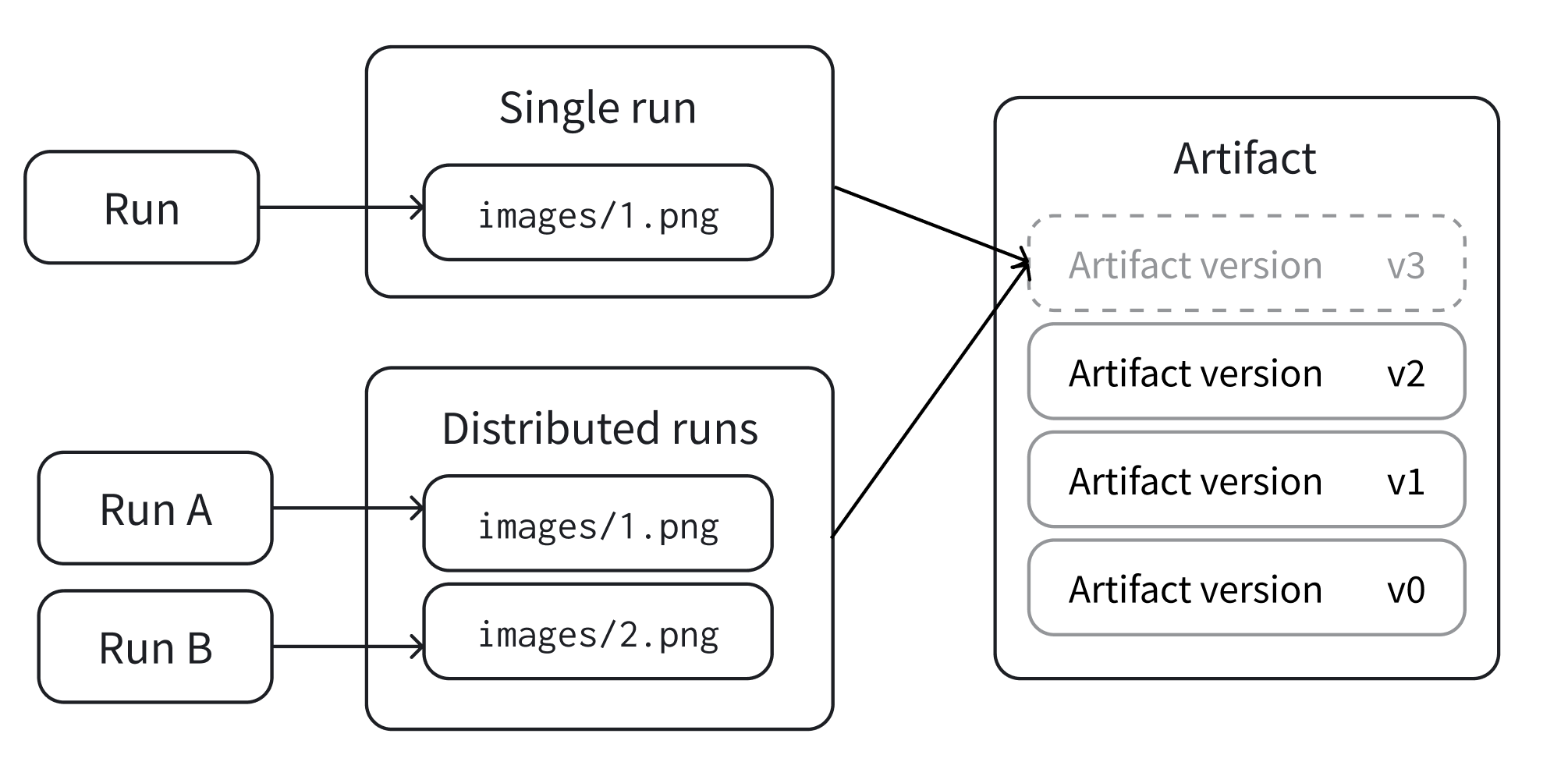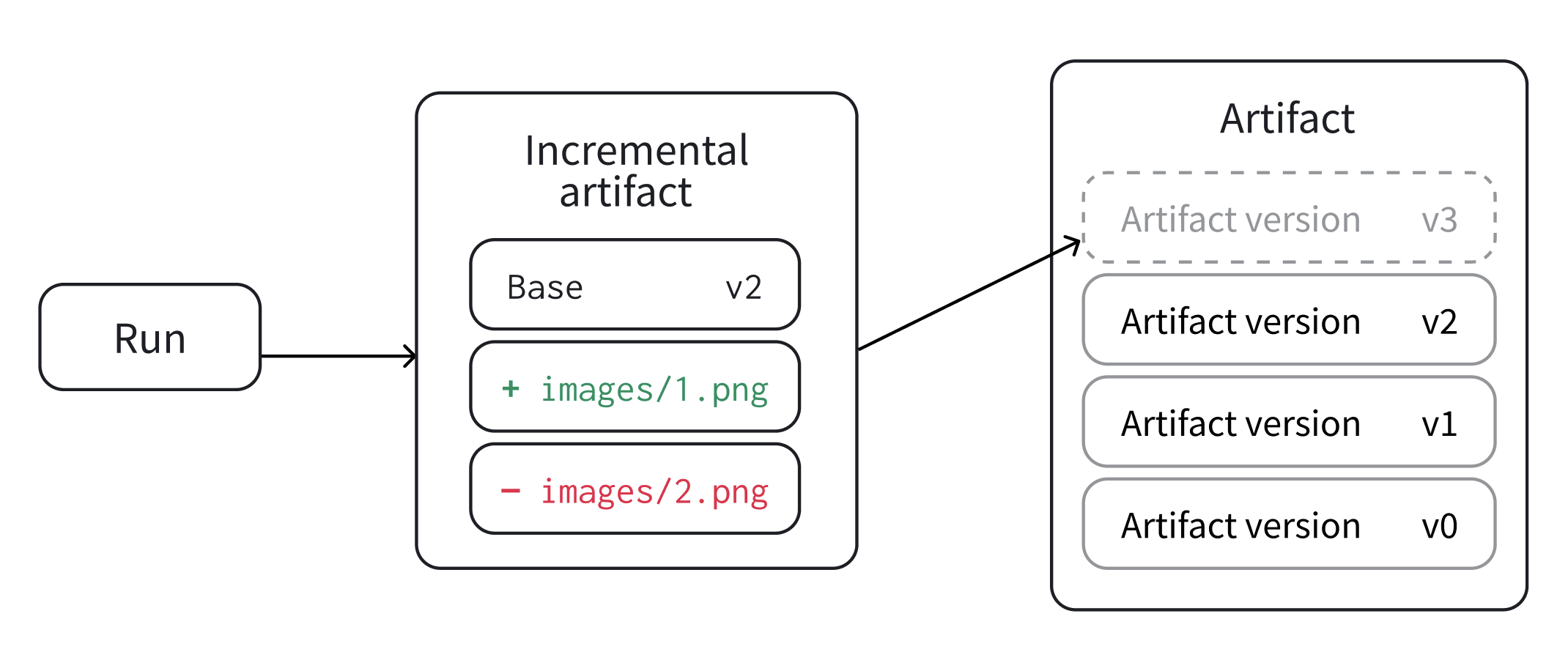Create new artifact versions
Create a new artifact version with a single run or collaboratively with distributed runs. You can optionally create a new artifact version from a previous version known as an incremental artifact.
We recommend that you create an incremental artifact when you need to apply changes to a subset of files in an artifact, where the size of the original artifact is significantly larger.
Create new artifact versions from scratch
There are two ways to create a new artifact version: from a single run and from distributed runs. They are defined as follows:
- Single run: A single run provides all the data for a new version. This is the most common case and is best suited when the run fully recreates the needed data. For example: outputting saved models or model predictions in a table for analysis.
- Distributed runs: A set of runs collectively provides all the data for a new version. This is best suited for distributed jobs which have multiple runs generating data, often in parallel. For example: evaluating a model in a distributed manner, and outputting the predictions.
W&B will create a new artifact and assign it a v0 alias if you pass a name to the wandb.Artifact API that does not exist in your project. W&B checksums the contents when you log again to the same artifact. If the artifact changed, W&B saves a new version v1.
W&B will retrieve an existing artifact if you pass a name and artifact type to the wandb.Artifact API that matches an existing artifact in your project. The retrieved artifact will have a version greater than 1.

Single run
Log a new version of an Artifact with a single run that produces all the files in the artifact. This case occurs when a single run produces all the files in the artifact.
Based on your use case, select one of the tabs below to create a new artifact version inside or outside of a run:
- Inside a run
- Outside a run
Create an artifact version within a W&B run:
- Create a run with
wandb.init. (Line 1) - Create a new artifact or retrieve an existing one with
wandb.Artifact. (Line 2) - Add files to the artifact with
.add_file. (Line 9) - Log the artifact to the run with
.log_artifact. (Line 10)
with wandb.init() as run:
artifact = wandb.Artifact("artifact_name", "artifact_type")
# Add Files and Assets to the artifact using
# `.add`, `.add_file`, `.add_dir`, and `.add_reference`
artifact.add_file("image1.png")
run.log_artifact(artifact)
Create an artifact version outside of a W&B run:
- Create a new artifact or retrieve an existing one with
wanb.Artifact. (Line 1) - Add files to the artifact with
.add_file. (Line 4) - Save the artifact with
.save. (Line 5)
artifact = wandb.Artifact("artifact_name", "artifact_type")
# Add Files and Assets to the artifact using
# `.add`, `.add_file`, `.add_dir`, and `.add_reference`
artifact.add_file("image1.png")
artifact.save()
Distributed runs
Allow a collection of runs to collaborate on a version before committing it. This is in contrast to single run mode described above where one run provides all the data for a new version.
- Each run in the collection needs to be aware of the same unique ID (called
distributed_id) in order to collaborate on the same version. By default, if present, W&B uses the run'sgroupas set bywandb.init(group=GROUP)as thedistributed_id. - There must be a final run that "commits" the version, permanently locking its state.
- Use
upsert_artifactto add to the collaborative artifact andfinish_artifactto finalize the commit.
Consider the following example. Different runs (labelled below as Run 1, Run 2, and Run 3) add a different image file to the same artifact with upsert_artifact.
Run 1:
with wandb.init() as run:
artifact = wandb.Artifact("artifact_name", "artifact_type")
# Add Files and Assets to the artifact using
# `.add`, `.add_file`, `.add_dir`, and `.add_reference`
artifact.add_file("image1.png")
run.upsert_artifact(artifact, distributed_id="my_dist_artifact")
Run 2:
with wandb.init() as run:
artifact = wandb.Artifact("artifact_name", "artifact_type")
# Add Files and Assets to the artifact using
# `.add`, `.add_file`, `.add_dir`, and `.add_reference`
artifact.add_file("image2.png")
run.upsert_artifact(artifact, distributed_id="my_dist_artifact")
Run 3
Must run after Run 1 and Run 2 complete. The Run that calls finish_artifact can include files in the artifact, but does not need to.
with wandb.init() as run:
artifact = wandb.Artifact("artifact_name", "artifact_type")
# Add Files and Assets to the artifact
# `.add`, `.add_file`, `.add_dir`, and `.add_reference`
artifact.add_file("image3.png")
run.finish_artifact(artifact, distributed_id="my_dist_artifact")
Create a new artifact version from an existing version
Add, modify, or remove a subset of files from a previous artifact version without the need to re-index the files that didn't change. Adding, modifying, or removing a subset of files from a previous artifact version creates a new artifact version known as an incremental artifact.

Here are some scenarios for each type of incremental change you might encounter:
- add: you periodically add a new subset of files to a dataset after collecting a new batch.
- remove: you discovered several duplicate files and want to remove them from your artifact.
- update: you corrected annotations for a subset of files and want to replace the old files with the correct ones.
You could create an artifact from scratch to perform the same function as an incremental artifact. However, when you create an artifact from scratch, you will need to have all the contents of your artifact on your local disk. When making an incremental change, you can add, remove, or modify a single file without changing the files from a previous artifact version.
You can create an incremental artifact within a single run or with a set of runs (distributed mode).
Follow the procedure below to incrementally change an artifact:
- Obtain the artifact version you want to perform an incremental change on:
- Inside a run
- Outside of a run
saved_artifact = run.use_artifact("my_artifact:latest")
client = wandb.Api()
saved_artifact = client.artifact("my_artifact:latest")
- Create a draft with:
draft_artifact = saved_artifact.new_draft()
- Perform any incremental changes you want to see in the next version. You can either add, remove, or modify an existing entry.
Select one of the tabs for an example on how to perform each of these changes:
- Add
- Remove
- Modify
Add a file to an existing artifact version with the add_file method:
draft_artifact.add_file("file_to_add.txt")
You can also add multiple files by adding a directory with the add_dir method.
Remove a file from an existing artifact version with the remove method:
draft_artifact.remove("file_to_remove.txt")
You can also remove multiple files with the remove method by passing in a directory path.
Modify or replace contents by removing the old contents from the draft and adding the new contents back in:
draft_artifact.remove("modified_file.txt")
draft_artifact.add_file("modified_file.txt")
- Lastly, log or save your changes. The following tabs show you how to save your changes inside and outside of a W&B run. Select the tab that is appropriate for your use case:
- Inside a run
- Outside of a run
run.log_artifact(draft_artifact)
draft_artifact.save()
Putting it all together, the code examples above look like:
- Inside a run
- Outside of a run
with wandb.init(job_type="modify dataset") as run:
saved_artifact = run.use_artifact(
"my_artifact:latest"
) # fetch artifact and input it into your run
draft_artifact = saved_artifact.new_draft() # create a draft version
# modify a subset of files in the draft version
draft_artifact.add_file("file_to_add.txt")
draft_artifact.remove("dir_to_remove/")
run.log_artifact(
artifact
) # log your changes to create a new version and mark it as output to your run
client = wandb.Api()
saved_artifact = client.artifact("my_artifact:latest") # load your artifact
draft_artifact = saved_artifact.new_draft() # create a draft version
# modify a subset of files in the draft version
draft_artifact.remove("deleted_file.txt")
draft_artifact.add_file("modified_file.txt")
draft_artifact.save() # commit changes to the draft